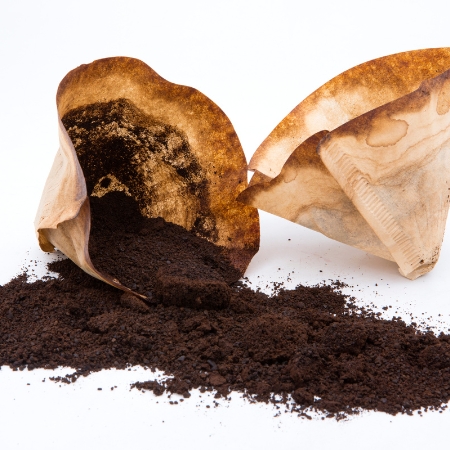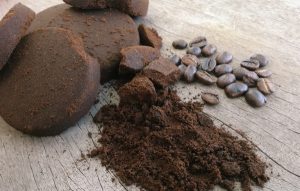With Earth Day coming up, we asked our team member Barista Kenyon, who knows a lot about keeping things eco-friendly, to talk about something most people don’t think about when they make their morning coffee: the byproducts of making coffee. Here’s what Kenyon suggests to help you reduce coffee waste in your everyday life:
Everyone has their own brewing method and every method creates its own waste. Just think about it: a little waste from making a cup of coffee may not seem like much, but multiply it by the 500 billion cups enjoyed around the globe every single year, that little waste adds up fast. Now I bet you’re wondering how you can reduce coffee waste. Luckily, we live in an age when there are many easy ways you can reduce coffee waste!
With the goal of leaving a better environmental footprint and being a more sustainable java drinker, let’s discuss the different methods of making coffee. Together we’ll explore the eco-conscious changes you can make to reduce, reuse and recycle your coffee byproducts.
Discovering Coffee Byproducts
Okay, so what is a byproduct? It’s simply the secondary product created when manufacturing something else. For example, when brewing coffee, coffee is the main product. The byproducts are the coffee grounds, filters, etc. Often, the byproducts are considered waste and are discarded.
Reduce Coffee Waste One Pod at a Time
I grew up with a single-serve coffee maker (a classic Keurig), so I’m no stranger to the single-use K-Cups or coffee pods. Ten years ago, it was all about “fill your mug and toss the pod.” As easy as that was, this practice created a lot of waste.
Today, we enjoy options to be more eco-conscious with the single-serving method. Many coffee pod companies, like Tayst Coffee Roasters, have helped make the switch from producing pods out of a non-recyclable medium (generally a #7 plastic) to recyclable plastics and biodegradable or compostable materials. And, once you’ve brewed your coffee it’s as simple as peeling off the lid, washing out the pod, and tossing it right into the recycle bin. (Be sure to check with your local composting service to see if this option works for them, too.) This may add an extra minute to the morning routine but will immediately reduce coffee waste. In turn it will reduce the amount sent off to the landfill – especially if you drink lots of coffee, like me!
The Rise of Reusable Coffee Pods
Looking for a great alternative to regular pods? Try reusable coffee pods. Don’t worry, this doesn’t mean reusing your old grounds. There are many single-serve coffee machine compatible pods. The My K-Cup Universal Reusable Coffee Filter has been my personal go-to when using a single-serve coffee machine. Why? Because it’s compatible and easy to clean. However, there are plenty of other options to fit your needs and your coffee brewer’s. These are great products because you not only get to eliminate the bulk of having boxes of prepared pods, but you also get to prepare and brew your favorite grounds of choice!
The Scoop on Paper Filters
Paper coffee filters. What would we do without them? It turns out there’s a lot! When making pour overs, AeroPress, or using any ol’ coffee machine, paper coffee filters are generally part of the process. Fortunately, almost all paper filters are biodegradable and can go right into the backyard compost. Under the right conditions, bleached and unbleached paper filters will fully biodegrade in 6 to 8 months and can be added to gardens and potted plants as nitrogen rich soil. Unfortunately, and more often than not, they go right from the machine to the garbage.
Reusable, Reliable to Reduce Coffee Waste
A strong alternative to reduce coffee waste and get rid of paper filters altogether is to go the reusable route. Fine mesh and stainless steel filters can be used in almost any standard coffee machine, aeropress, or pour over. As long as you have the right size and fit, you’ll notice little to no change in the flavor profile and potentially produce stronger aromas when using stainless steel. Although higher in price than a pack of paper filters, this is a long term and sustainable investment for anyone who frequently drinks coffee and ultimately keeps filters off the grocery list and out of the landfill.
Pour Over Preference
Stainless steel filters have already become a fairly common practice for pour overs. I personally use the LHS Pour Over Coffee Dripper. It’s simple to use, has rubber edges to stay put on top of your mug while brewing, and even comes with a small brush for easy cleaning. Once you have made your pour over, simply discard the grounds (ideally into the compost) and give the filter a quick rinse under the sink with warm water. The bottom line: if you can’t kick paper filters, make sure they are being composted. Otherwise switch to a reusable filter today!
Going Paperless: Sustainable Brewing Methods
The French press and moka pot are both popular methods for making the daily brew. In fact, I just learned that Espresso Dave enjoyed coffee brewed in a moka pot as a teenager! Even though they work differently, both methods only produce one thing we want – a nice hot drink – and one extra thing we don’t use as much – the leftover coffee grounds (the byproduct).
Moka Pot Madness
In a 2021 scientific article, the moka pot was identified as being the lowest carbon footprint brewing method based on energy used to actually brew, low amount of packaging and materials that go to waste, and other factors (M. Cabelli et al.). A carbon footprint is the amount of greenhouse gasses generated from an individual or group’s actions. If you’d like to get into the nitty gritty of science in this article, I highly encourage giving “Carbon footprints of different methods of coffee preparations” a read. A lower carbon footprint almost always translates to a sustainable activity making the French press and moka pot great choices for the eco-friendly coffee drinker.
Sustainable Coffee Habits for a Greener Future to Reduce Coffee Waste
In the spirit of the upcoming Earth Day, it is important to start to think about our everyday habits and how to make them more sustainable. Like I said earlier, a little waste from making a cup of coffee may not seem like much, but multiply it by the 500 billion cups enjoyed around the globe every single year, that little waste adds up fast. Espresso Dave’s is always working to find new ways to reduce our waste and you can too:
- Kick the paper and invest in a stainless steel filter for your pour over.
- Educate your friends and family on how they can reduce coffee waste in their everyday life.
- Repurpose those coffee pods into this year’s flower garden starters (stay tuned for the how-to post.)
Whatever you do – no matter how big or small – is making a difference and keeping Earth a cleaner place for us all to enjoy a hot cup of java. Cheers to sustainable practices! For additional sustainable coffee practices, check out this blog post.
 Guest Blogger
Guest Blogger
Espresso Dave’s very own Barista Kenyon studied Environmental Conservation and Sustainability at the University of New Hampshire. When he’s not serving up caffeinated cheer at our events, he’s outdoors mountain biking, rock climbing, trail running and exploring new places across the US as well as spreading the word on the importance of being an environmental steward in everyday life.







